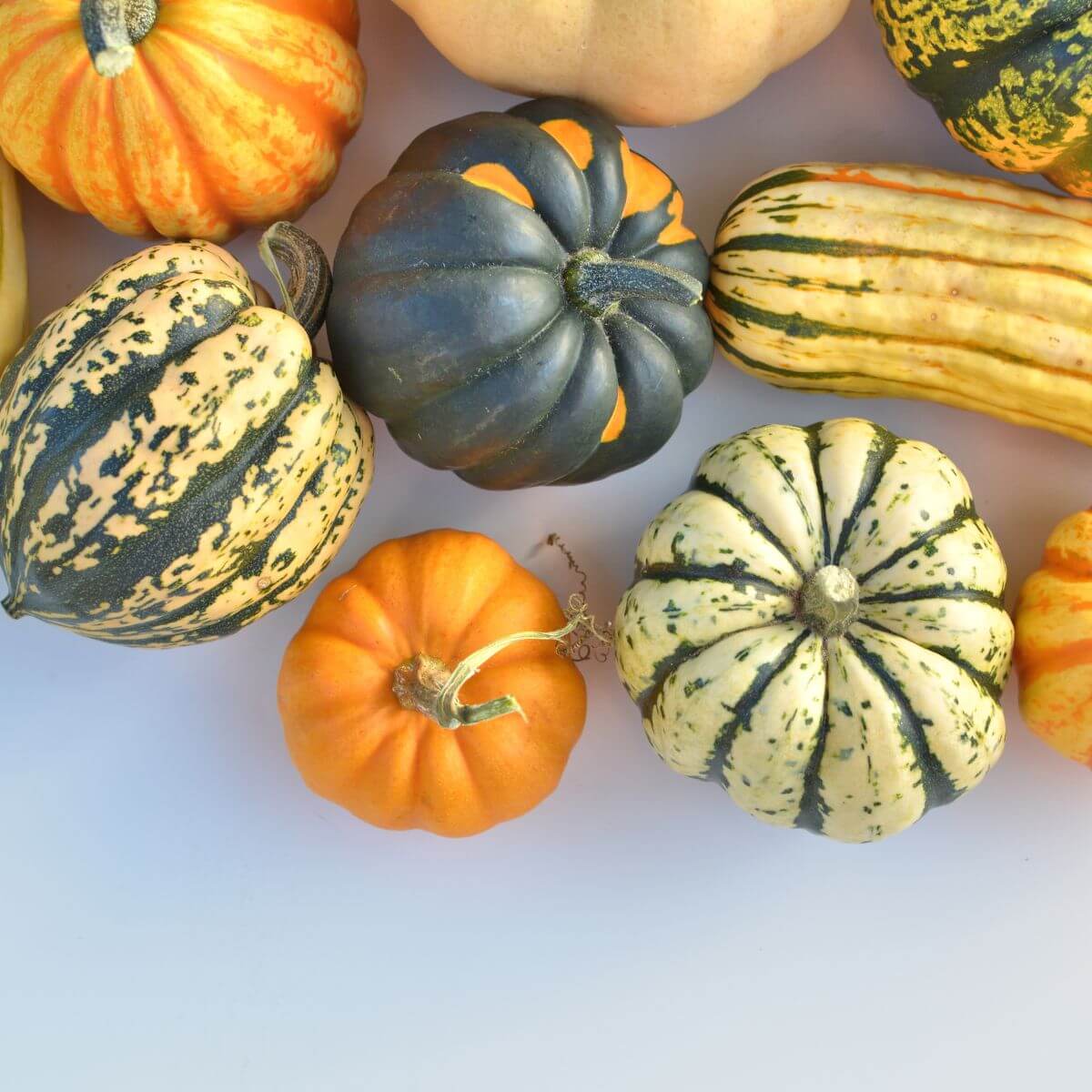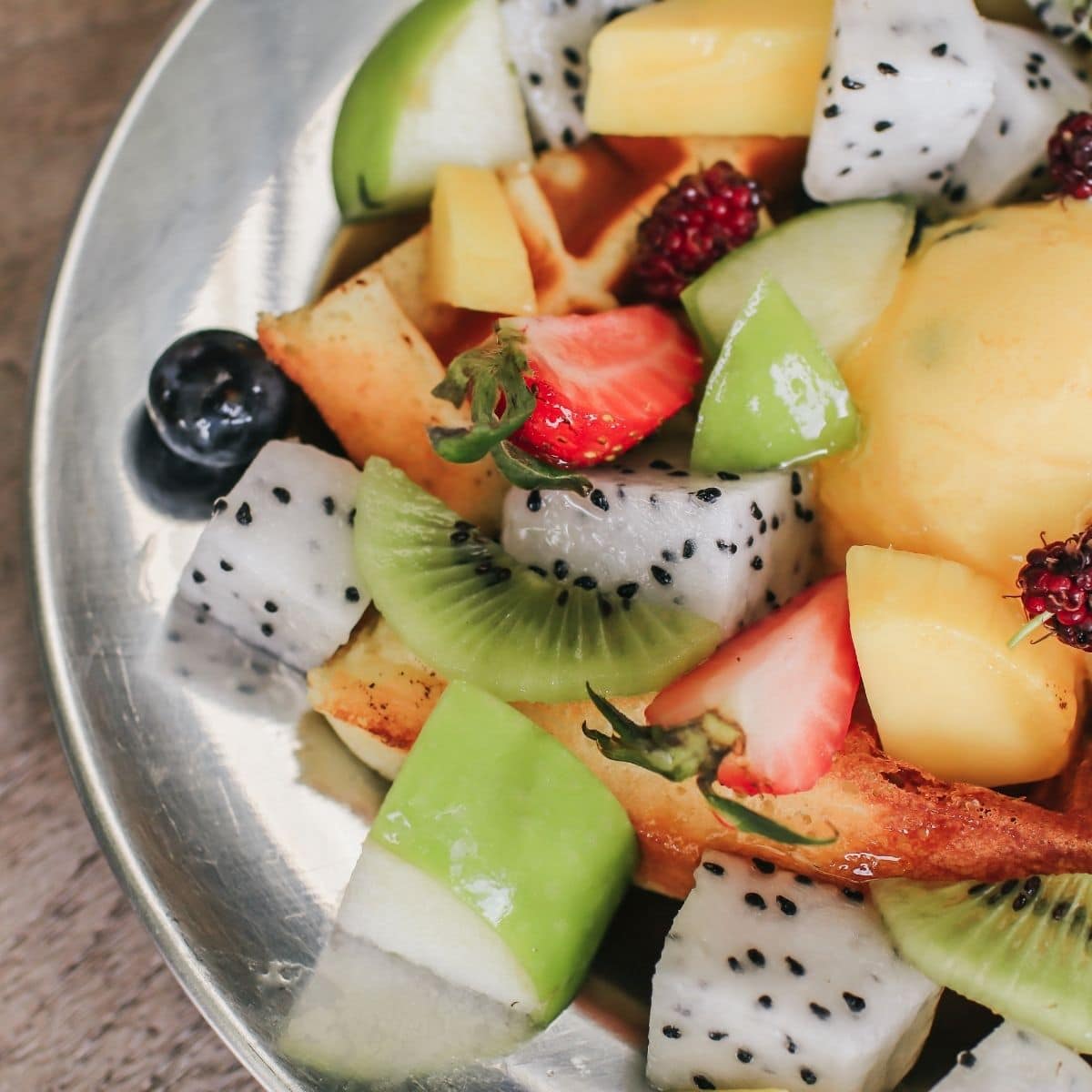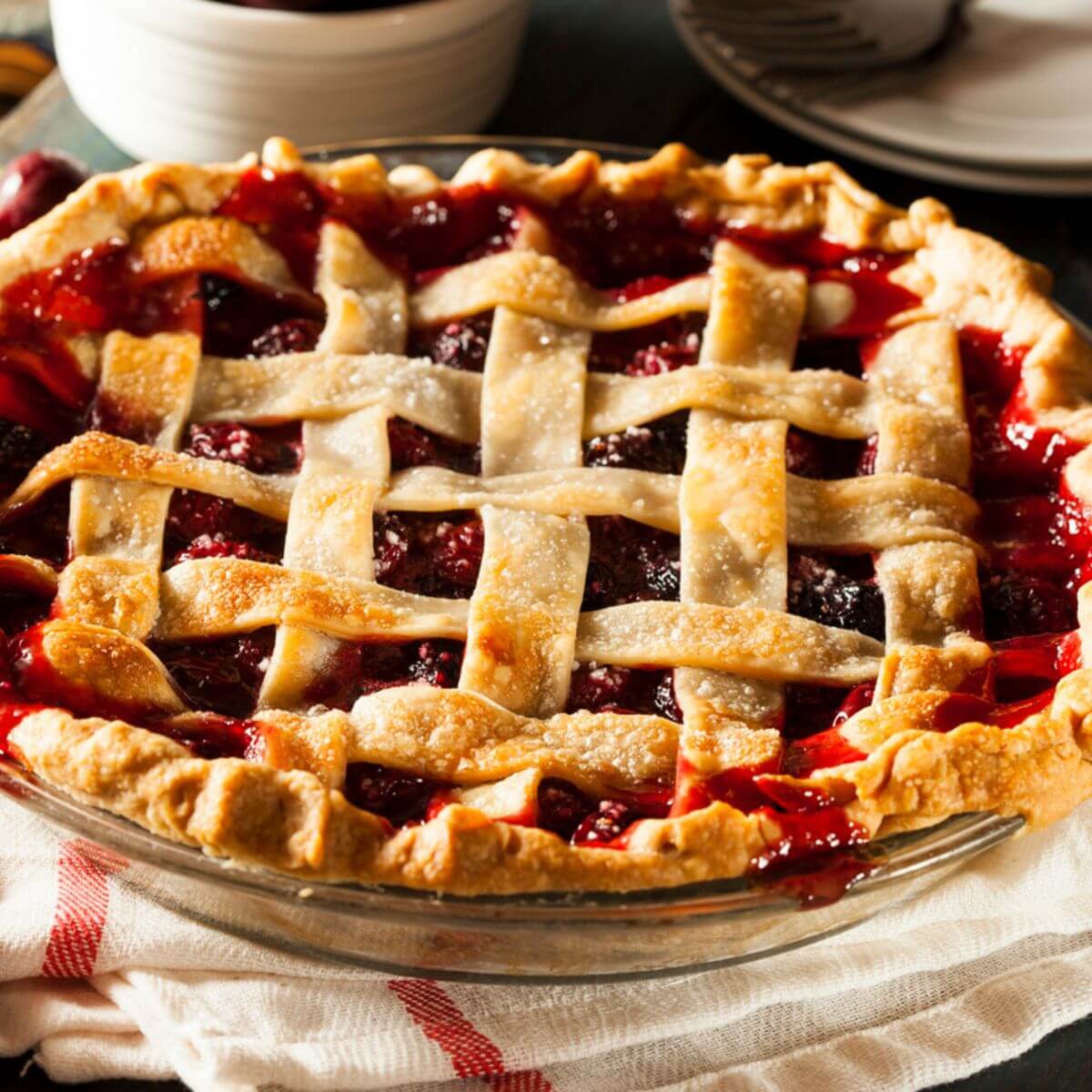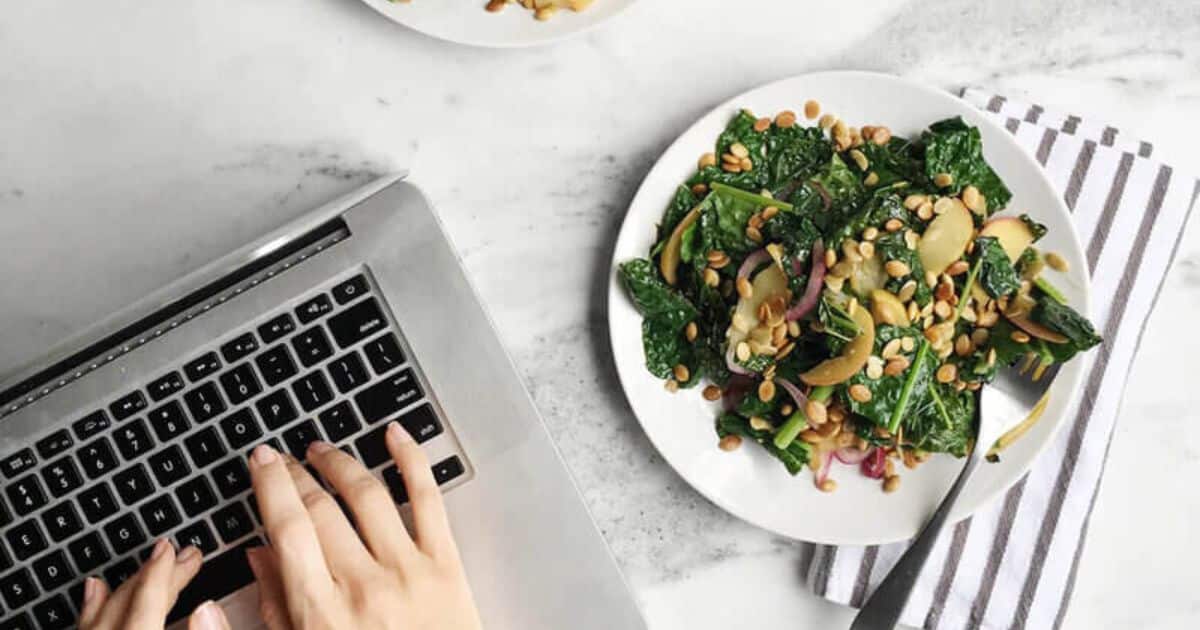Did you ever want to learn more about the many types of winter squash that are out there? I know – they’re intimidating. The mounds of colorful, tough-skinned squash and gourds arranged in boxes outside the automatic grocery doors as their more approachable, thin-skinned cousins nestle in their cozy produce-aisle beds. Let’s learn all about the different types of edible winter squash and some nutrition facts and health benefits.

There’s no doubt that members of the Cucurbitaceae family, notably pumpkins, gourds, and winter squash, are beautiful, if not interesting, ornamental works of Mother Nature.
But it seems that many are destined to be arranged on the front stoop of every suburban home from November through December.
Underneath their colorful, sometimes rough, exteriors is nutrient-dense flesh that does well in soups – it’s just the right amount of starch to yield a creamy texture. Of course, straight up baking or roasting your squash is always an option.
Many varieties have edible skins and do not need to be peeled.
Kabocha Squash
Also known as Japanese pumpkin, kabocha squash has green skin, orange flesh, and a shape similar to pumpkin. The flesh is super sweet when cooked and is rich in beta-carotene – 1 cup has more than 200% DV of vitamin A!
Before preparing for cooking, place whole squash in a 350°F oven for about 20 minutes to soften the skin – it will make cutting, peeling, and chopping an easier and much safer experience.
Try using kabocha in place of the butternut squash in your favorite soup.
Acorn Squash
Acorn squash varies in color from dark green to tie-dyed green with orange shades. The flesh of this winter squash is less sweet than kabocha and is more yellow than orange.
Just one cup provides more than 25% DV of vitamin C.
You can soften the squash if needed by heating in the oven, although it is small enough that this may not be needed.
Trim the top from each squash, invert on the cutting board, and slice from bottom to top to create two halves. Remove seeds. You can bake the halves with a drizzle of olive oil and a touch of maple syrup for 30 minutes at 350°F – an excellent side dish. You can also slice into half moons to prepare for roasting.
Sugar Pumpkin
Sugar pumpkins look like carving pumpkins, so be sure to select those marked especially for cooking. They are sweeter than those cultivated for jack-o-lantern displays.
The best way to cook the flesh is to roast the entire pumpkin – this allows the flesh to remain moist and helps the sugars develop.
Remove stem from pumpkin, rinse, and make several slits through the skin with a sharp knife. Bake at 350°F for about an hour. Remove from the oven and let sit until cooled. Cut the top portion off [around where the stem would be], remove seeds, and scoop out flesh.
I’ve been known to add pumpkin to my hummus and stir into my yogurt. Of course, you can always use it for baking! The color of sugar pumpkins closely resembles a deep orange sweet potato. Both vegetables are rich in vitamin A.
Spaghetti Squash
This is probably my favorite type of squash, because “vegetable spaghetti” is my go-to replacement for traditional spaghetti pasta.
Since I have celiac disease, which means I only eat gluten-free recipes, spaghetti squash is what I use in place of regular gluten filled spaghetti.
Butternut Squash
This other type of edible winter squash is technically a fruit. While there are so many types of winter squash, this one seems to be the most popular one to cook.
📥 GET THIS ARTICLE IN YOUR INBOX 📥
It has a combination of sweet and nutty flavor, which becomes more flavorful when cooked. There are various ways butternut squash is best prepared.
Roasted is the most popular way to cook, but you can also sauté, mash, or puree once tender. Roasted with a bit of olive oil, cinnamon, maple syrup, or brown sugar is simply a delicious way that I love to prepare in the oven.
It is also great made as a soup. It is rarely eaten uncooked, because of how tough it is.
This is a tricky one to cut, so be very careful while cutting the tough outer rind. When cooking in the oven, no need to peel the outer rind, just cut in half, remove the seeds, and simply roast in the oven.
Roasting with the flesh-side down is the best way to boost the flavor profile of the inner flesh.
If you are choosing to peel first, I advise first poke several times with a fork and then putting the entire squash in the microwave first for about 30 seconds, to help soften the peel for peeling with a sharp vegetable peeler.
First, slice off the bottom 1/4 -inch end of the squash. Then peel using downward strokes. After peeling, keep the squash stable and carefully cut down the center to cut in half. Then remove the seeds, save them to toast up later as a great snack. Continue to cut into slices and then cubes.
The easiest way I have found to cook is uncut whole in a slow cooker. Just place the entire squash in the slow cooker on high for 3-4 hours or low for 6-8 and it is tender and cooked perfectly.
Let’s talk about the nutritional content of this winter squash. It is brimming with vitamin A, almost 67% of one’s daily recommended value.
Delicata Squash
This other type of edible winter squash is probably on the top of my list for ease of preparation! Delicata squash has a mild, nutty flavor, firm flesh, and thin edible skin.
Preparing this variety could not be simpler: rinse, cut in half, remove seeds, slice into half-moons, toss with some olive oil and salt, and bake at 350°F for about 20 minutes until browned.
Delicious enough to eat on their own as a fiber-rich snack!
Easy Snack Tip
Food companies have made it their business to repurpose this compost-worthy waste into delicious edible snacks – but you can do this too! Rinse any remaining flesh from seeds and lay out on paper towels to dry.
For savory, toss with a bit of olive oil, seasoning of choice, and salt and pepper to taste.
For sweet, toss with a bit of melted coconut oil, a touch of maple syrup, cinnamon or other spice, and a pinch of salt. Sweet and savory – why not! All combinations are on the table, including adding a little kick with some cayenne pepper.
Roast seeds on a parchment-lined baking sheet at 350°F for about 10-15 minutes or until lightly browned.
Enjoy as a snack or topping for salads, yogurt, oatmeal, or chia pudding. If you want, you can plant some squash seeds, so you can grow your own types of squash right at home.
Here are some squash seeds I have purchased before.
Winter Squash Eating Suggestions
Here are a few ways that I enjoy eating winter squash.
- Butternut Squash Coconut Curry Soup
- Simple Roasted Butternut Squash Fall Harvest Salad
- Spicy Ginger Beef Spaghetti Squash Bowl Recipe
- Pumpkin Cranberry Sheet Pan Pancakes
- Maple Dijon Sheet Pan Chicken with Fall Vegetables
- Pumpkin Spice Anti-Inflammatory Gummies
- Starbucks Gut Healthy Pumpkin Spiced Latte Recipe
Let’s Discuss Types Of Edible Winter Squash! Which Is Your Favorite Type Of Winter Squash?
Let me know if you learned anything new about the types of winter squash there are and how to cook with them. Did you get any new ideas from me? Let me know in the comment section below.
You can also connect with me @EatYourNutrition on Instagram. I love seeing your photos. #EatYourNutrition #LauraVillanueva
Discover more from Eat Your Nutrition™
Subscribe to get the latest posts sent to your email.






